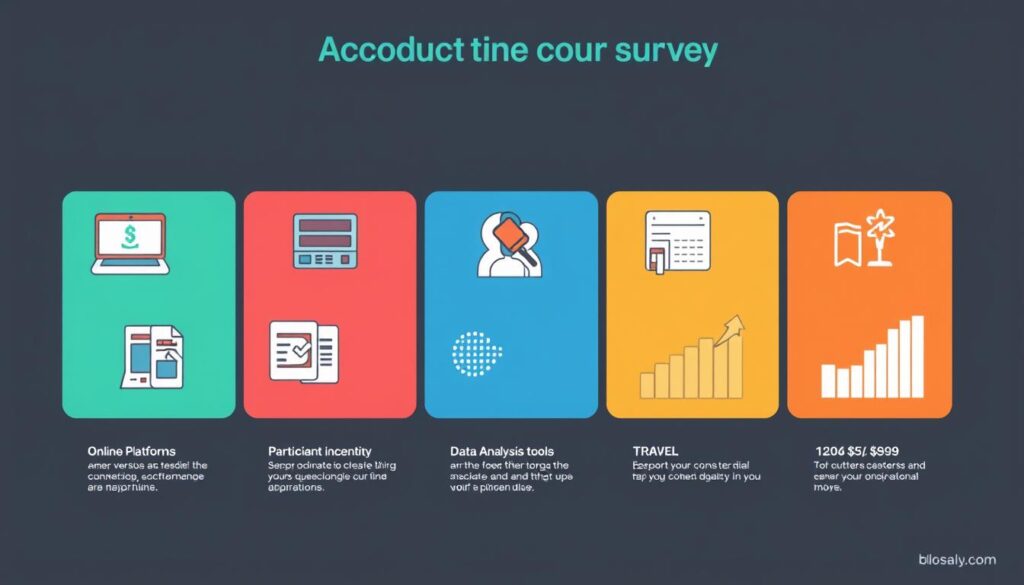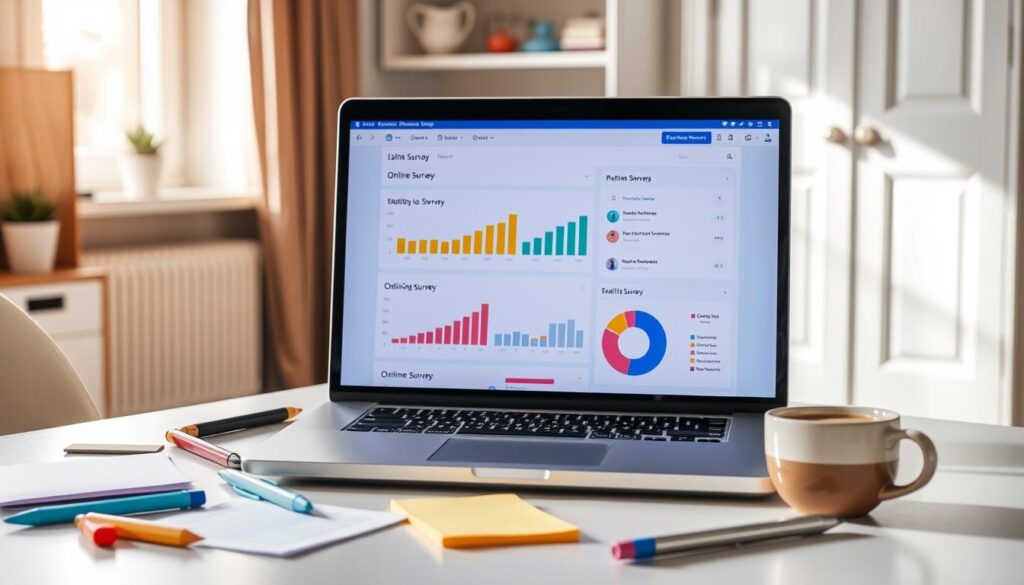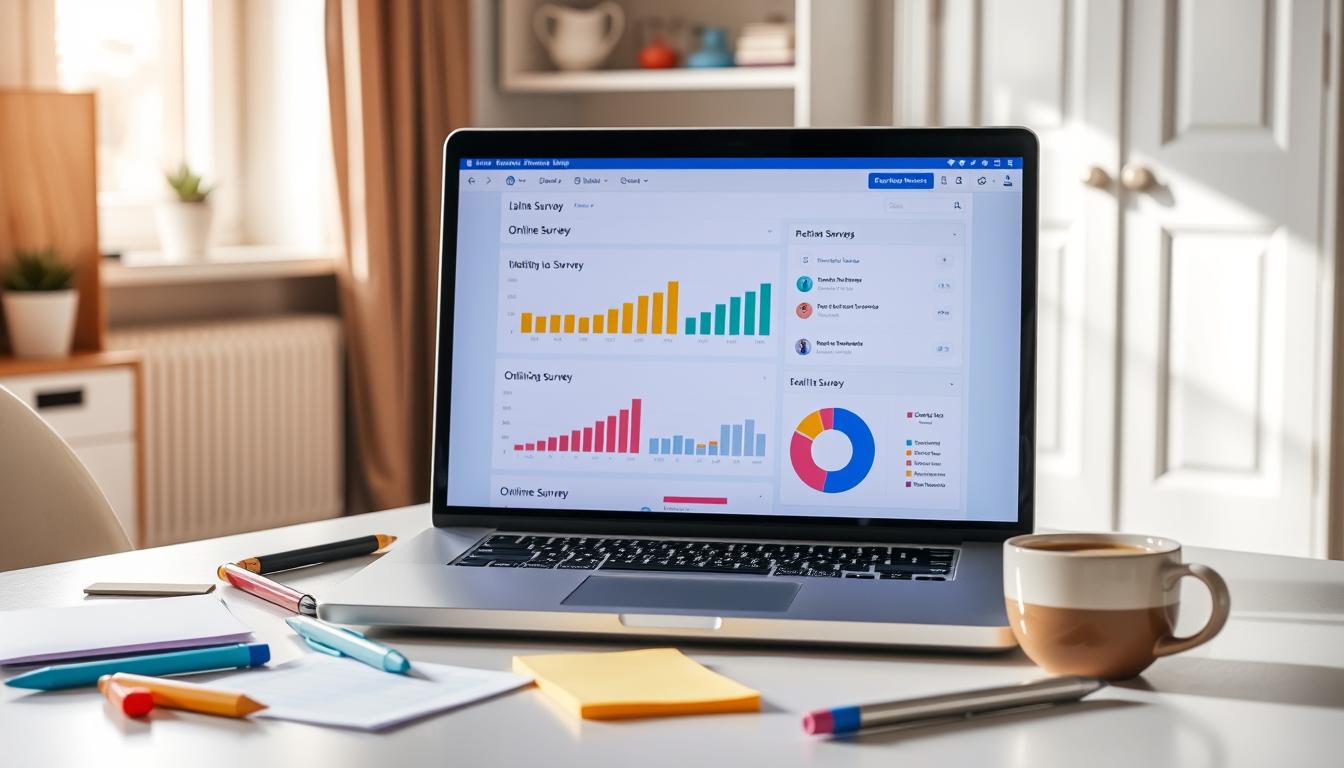Surveys are great for businesses and researchers to get important data. But, the cost of surveys can be a big deal. It’s key to know what affects survey prices to plan and budget well. We’ll look at the different costs of surveys, from online to in-person, to help you understand the costs of your next survey.

Key Takeaways
- Survey costs can vary widely depending on the type of survey, sample size, and other factors.
- Understanding the pricing ranges for different survey methods, such as online, phone, and in-person, is crucial for budgeting.
- Factors like geographic coverage, survey length, and complexity can significantly impact the overall survey cost.
- Choosing the right survey platform or research company can help manage costs and maximize the value of your survey data.
- Considering hidden costs like data analysis and participant incentives is essential for accurately estimating the total survey expenses.
Understanding Survey Types and Their Price Ranges
Choosing the right survey method can greatly affect costs. From online surveys to telephone surveys and in-person surveys, each has its own benefits and costs. Knowing the price ranges for these survey methodologies helps you pick the best option for your budget and goals.
Online Survey Platforms
Online survey platforms are now a popular choice. They are affordable and quick to use. The cost of online surveys varies, from free to hundreds of dollars. Many platforms offer different pricing levels, so you can adjust your spending as needed.
Phone Surveys
Telephone surveys offer deep insights but require more effort. The cost can be from $10 to $50 per interview. This depends on the survey’s length, who you’re surveying, and how complex it is to gather data.
In-Person Surveys
Face-to-face surveys provide a personal touch but are pricier. Costs can be from $20 to $100 per interview. This depends on where you’re surveying, how many interviewers you need, and the survey’s complexity.
Choosing the right survey methodology depends on your goals, who you’re surveying, and your budget. By knowing the costs of different surveys, you can choose wisely and get the most from your research.
How Much Does It Cost to Conduct a Survey: Breaking Down the Numbers
Planning and budgeting are key to a successful survey. The cost can change a lot based on several factors. These include the survey type, how many people you survey, where they are, and how complex it is. Let’s look at what usually costs in survey research.
Survey Setup and Design Costs
The setup and design of a survey can be a big part of the budget. This includes making the questionnaire, testing it, and putting it online or preparing for interviews. Costs can vary a lot, from a few hundred to several thousand dollars, based on complexity and expertise needed.
Data Collection Expenses
Collecting data is another big cost. Online surveys charge per response, from $0.50 to $5. Phone or in-person surveys add costs for interviewers, travel, and participant incentives. These costs can grow fast, especially for big surveys covering many areas.
Data Analysis and Reporting
After collecting data, you need to analyze it and make useful insights. This involves statistics, visuals, and a detailed report. Costs vary based on the analysis needed and whether you do it yourself or hire experts. They can range from a few hundred to several thousand dollars.
Here’s a cost breakdown for a medium-sized online survey with 500 respondents:
| Cost Component | Estimated Cost |
|---|---|
| Survey Design and Setup | $1,500 – $3,000 |
| Data Collection (500 responses at $2 per response) | $1,000 |
| Data Analysis and Reporting | $1,000 – $2,500 |
| Total Estimated Cost | $3,500 – $6,500 |
This breakdown helps you understand the costs of a survey. Remember, your actual costs might be different based on your project’s needs.
Factors Affecting Survey Pricing
Several key factors influence the cost of a survey. Knowing these can help businesses and researchers manage their budget better. This ensures they get the most from their research.
Sample Size Impact
The size of the sample is a major cost factor. A bigger sample means more people to survey, which raises costs. It’s important to find the right balance between sample size and cost.
Geographic Coverage
The area covered by the survey also affects the cost. Surveys that reach more places need more resources for finding participants and analyzing data. Focusing on a specific area can help control costs.
Survey Length and Complexity
The design of the survey also plays a role. Longer, more complex surveys take more time and effort. Making the survey shorter and simpler can lower costs.
| Factor | Impact on Survey Pricing |
|---|---|
| Sample Size | Higher sample sizes lead to increased costs for participant recruitment and data collection. |
| Geographic Coverage | Surveys covering a wider geographic area incur higher costs for participant recruitment, data collection, and analysis. |
| Survey Length and Complexity | Longer surveys with more complex question structures require greater resources for administration and analysis. |
Understanding these factors helps businesses and researchers make better choices. They can design surveys that fit their budget and goals, getting the most from their research.
DIY Survey Tools vs Professional Research Companies
Businesses have two main choices for surveys: self-service survey tools or professional market research companies. Each has its own benefits. Your choice depends on your budget, how much you know, and what you want to learn.
The Rise of Self-Service Survey Software
Survey software has made it easier for businesses to do surveys themselves. These tools are easy to use and offer many features. You can customize them and get results quickly.
Using DIY surveys is cheaper and gives you more control. You can make your surveys fit your specific needs.
Benefits of Professional Research Companies
Professional market research companies offer a more detailed approach. They know a lot about different industries and use advanced methods. They can give you insights you might not get on your own.
While it costs more, the quality of their data and analysis is worth it. It can help your business make better decisions.
| Self-Service Survey Tools | Professional Market Research |
|---|---|
| Cost-effective Customizable Real-time data analysis Flexible scheduling | Expertise and industry knowledge Advanced methodologies Comprehensive data analysis Strategic guidance |
Choosing between self-service surveys and professional market research depends on your business. Think about what you need and what you can afford. This will help you decide what’s best for your business.

Hidden Costs in Survey Research
Creating a survey is more than just asking questions. There are hidden costs that can affect your budget. Let’s look at the expenses you might not see coming.
Data Analysis Expenses
Data analysis is key to understanding your survey results. It involves cleaning and interpreting the data. This can lead to extra data analysis fees.
The cost depends on how complex your survey is and how detailed the analysis needs to be. These fees can add up fast.
Survey Design Costs
Making a good survey takes skill and care. It includes creating questions and designing the survey flow. The survey design expenses can be high, especially if you hire experts.
Participant Incentives
To get more people to take your survey, you might offer respondent incentives. These can be gift cards, cash, or chances to win something. While they help, they also increase your budget.
Knowing about these hidden costs helps you plan better. This way, your survey can be a success without any unexpected expenses.
Cost-Saving Strategies for Survey Research
Surveys are key in research, but they can get pricey. Luckily, there are ways to save money without losing data quality. Here are some budget-friendly strategies to help stretch your research budget.
Leverage Existing Resources
Look at any budget-friendly surveys or data you already have. Using internal or public datasets can save you money. Also, team up with other groups or researchers to share data and cut costs.
Optimize Survey Design
Good survey design is crucial for saving money. Use fewer questions, clear language, and avoid complexity. This makes surveys quicker and cheaper, boosting response rates.
Explore Alternative Data Collection Methods
Try different ways to collect data, like online panels or social media. These are budget-friendly surveys options. Also, use customer feedback or transaction records to fill gaps in your survey data.
By using these cost reduction techniques and affordable research methods, you can get great insights without spending too much. A bit of creativity and planning can make your survey research effective and affordable.

Survey Platform Pricing Comparisons
Choosing the right survey platform can affect your costs. Prices vary from free to hundreds of dollars a month. We’ll look at the main differences to help you pick the best option for your budget and needs.
Popular Survey Tools
Big names like SurveyMonkey, Qualtrics, and Google Forms offer various plans. They charge based on responses, features, and customization. Prices start at $0 for basic plans and go up to hundreds for advanced features.
Enterprise Solutions
For big surveys, tools like Qualtrics, Alchemer, and SurveyGizmo are good choices. They offer advanced data analysis, security, and question types. But, they cost more, with prices starting in the thousands for annual contracts.
Free Survey Options
For those on a tight budget, Google Forms, SurveyPlanet, and SurveyLegend are free. They’re great for small surveys or personal use. With no cost, they’re a good starting point.
When picking a survey platform, think about your needs, budget, and required features. Knowing what each tool offers helps you choose the right one for your goals and budget.
Timeline Considerations and Cost Implications
The timeline greatly affects the cost of survey research. A tight deadline means more resources and higher prices. This is compared to projects with more flexible schedules.
Research scheduling is key to saving on costs. Tight deadlines might mean faster data collection, extra staff, or premium platforms. These can raise the budget. On the other hand, projects with more time can plan better, use cheaper methods, and get better rates.
Time-sensitive surveys like market trends or event feedback can be costly. Researchers must choose between speed and saving money. Good project management and clear talks with stakeholders help manage these issues. This ensures the survey project timeline fits the budget.
FAQ
How do different survey types impact the cost of conducting a survey?
Online surveys are usually the cheapest. Phone and in-person surveys cost more.
What factors influence the overall cost of a survey project?
Several things affect survey costs. These include the number of people surveyed, where they are, and how long the survey is. Also, what analysis is needed and if you offer incentives. Planning well can help keep costs down.
How do DIY survey tools compare to hiring professional research companies in terms of cost?
DIY tools are cheaper for small projects. But, for big or complex surveys, experts are worth the extra cost. They bring skills and resources that save time and money in the long run.
What are some hidden costs associated with survey research that people often overlook?
There are hidden costs like data analysis and survey design. Also, paying participants can add up. Knowing these costs helps plan the budget better.
What are some effective cost-saving strategies for conducting surveys on a budget?
Save money by using what you already have. Make your survey design efficient. Look for cheaper ways to collect data. And talk to survey platform providers to get a good deal. These steps help keep costs low without sacrificing quality.
How do the pricing models of different survey platforms compare?
Survey platforms have various pricing models. Some offer subscriptions, others are free. It’s important to compare what each offers to find the best value for your needs.
How does the project timeline affect the cost of conducting a survey?
A tight deadline can increase costs. It might mean paying more for quick services. Good planning helps manage costs while meeting deadlines.



